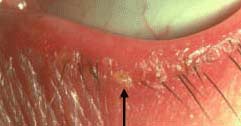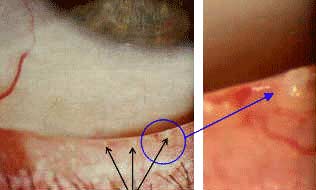Blepharitis refers to chronic inflammation of the eyelids. Blepharitis is one of the most common disorders of the eye and is often the underlying reason for eye discomfort.
Blepharitis is chronic (ongoing) in nature and occurs in two forms depending upon location:


Everyone has bacteria on the surface of their skin, but in some people, bacteria especially thrive in the skin at the base of the eyelashes. Excessive amounts of bacteria around the eyelashes can cause dandruff-like scales and particles to form along the lashes and eyelid margins.
Blepharitis is also associated with meibomitis – dysfunction and inflammation of the nearby oil glands of the eyelids (called meibomian glands). When functioning normally, these glands secrete a thin oily coating into the natural tear film that helps to prevent rapid evaporation and therefore helps keep the eyes moist.
Generally, the main causes of blepharitis are:
Treatment is usually ongoing and sometimes frustrating, depending on the type of blepharitis you have. Expect to keep up therapy for a prolonged period of time to keep it at bay. Treatment may include:
In addition to alleviating the redness and soreness, proper treatment may prevent future infection and scarring of the cornea. A complete eye examination by a qualified eye care professional is essential.
The warm compress portion of treatment is designed to loosen crusts on your eyes before you cleanse them.
Wash your hands, then dampen a clean washcloth with very warm water, wring it out and place it over your closed eyes for at least one minute. Repeat two or three times, wetting the washcloth again with warm water as it cools. This will loosen the scale and debris around your eyelashes. It also helps dilute oil secretions from nearby oil glands, preventing the development of chalazion (pronounced chuh-LAY-zee-un) – an enlarged lump caused by clogged oil secretions in the eyelid. An alternative variation involves adjusting the shower so that it is a very gentle stream of very warm (but comfortable!) water that is allowed to flow over the gently closed eyelids for about 1 or 2 minutes.
When you first begin treatment, do this four times a day, for at least five minutes each time. Later on, you might apply the compress once a day, for a few minutes. Your doctor will tell you the specific treatment needed for your eyes.
Cleansing the eyelids is essential to blepharitis treatment. Dr. Seibel will recommend what to clean them with: warm water only, baby shampoo diluted with warm water or a special product made for cleansing the lids.
First, wash your hands, then dip a clean washcloth (typically draped over your index finger for control), cotton swab, gauze pad, or commercial lint-free pad into your cleaning solution. Gently wipe it across your lashes and lid margin for about 15 seconds per eyelid. Use a magnifying mirror if necessary to avoid accidentally rubbing the eyeball itself. Rinse with cool water. When you first begin treatment, your doctor may have you cleanse your lids several times a day. Later on, you will probably cleanse them about once a day.
Because blepharitis can be a persistent problem, you should practice good skin and eyelid hygiene to prevent recurrences. In addition to careful cleansing of your eyelashes, washing your hair, scalp and eyebrows with antibacterial shampoo can also help control blepharitis.
In some cases, it is necessary to use prescribed eye drops, ointment or oral medication along with the daily cleansing regimen. Be careful to follow recommended dosages. And with any medication, there is a small possibility of allergy or other reaction, including skin rash, slight nausea and increased sensitivity to sun.
Antibiotic ointment should be applied using a clean fingertip or cotton swab; gently apply a small amount at the base of the eyelashes before bedtime.
Artificial tears or steroid eye drops may also be prescribed temporarily to relieve dry eye or inflammation. Although medications may help control the symptoms of blepharitis, they alone are not sufficient; keeping the eyelids clean to reduce bacterial count is essential.
arrow up Back to treatment list
If you have meibomian gland dysfunction (MGB), Dr. Seibel will probably recommend massaging the lids to remove excess oil. Do not use this technique unless specifically recommended by your doctor after a careful eye examination
In MGD, the meibomian (oil) secretions are thick and the gland openings are clogged. Think of a toothpaste tube that contains butter instead of toothpaste. When cold, you would not be able to squeeze the butter out of the tube. However, once you warm it a bit, then the butter will soften enough to come out of the tube, but some pressure on the tube (squeezing) would still be necessary.
Going by this analogy, after you have applied warm compresses, the thick oils in your lids will be more fluid, but a particular type of massage will be necessary to express them. Therefore after every minute of warm compresses, massage the eyelids as follows:
Gently close the eyelids. Put your index finger on the outer corner of the eyelid. Pull the eyelid towards the ear, so that the eyelids are stretched taut. Next use the index finger of the opposite hand to apply direct pressure to the taut eyelids starting at the inner aspect of the eyelid near the base of the nose. Sweep with firm but gentle pressure towards the ear. Repeat this maneuver four to five times. The goal is to apply gentle pressure to the eyelids as if you were squeezing a tiny tube of toothpaste – just rubbing the eyelid surface will not be nearly as productive. If you have any questions, please call us at Seibel Vision Surgery(310) 444-1134.
At Seibel Vision Surgery, your eyes and vision are of paramount importance. To help you make the most informed decisions regarding the welfare of your vision, we are delighted to be of service and are happy to answer any questions you may have.
Please take the time to familiarize yourself with the information contained on this site. We have compiled it especially for you!
Monday, Tuesday, Wednesday, and Thursday
8:30 a.m. to 3:30 p.m.
Friday
8:30 a.m. to 3:00 p.m.
OUR ADDRESS
11620 Wilshire Boulevard, Suite 711
Los Angeles, California 90025
PHONE
(310) 444-1134
FAX
(310) 444-1130
Learn about cataracts and their treatment
Learn more about CataractsGlaucoma, Macular Degeneration,
Medical Eye Exams, and other